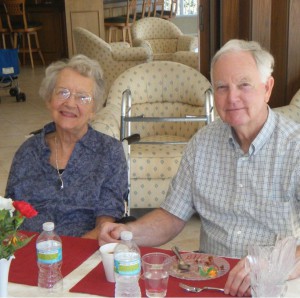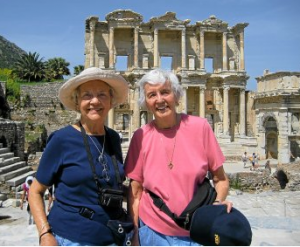Health & Fitness
Overcoming Guillain Barre Syndrome (GBS) – A Hope-Inspiring Story of Courage & Determination

This is a story of true courage and determination with an uplifting ending that will help anyone suffering from Guillain Barre Syndrome (GBS) or similar life-threatening challenges, as well as their caregivers.
Jackie’s example will inspire you to never give up hope and to keep going day by day by day with the hard work of physical therapy, even when progress seems slow, knowing that full recovery can one day be yours.
Constance Barnhart
Editor
Read Jackie’s story, in her own words…
MY YEAR WITH GUILLAIN BARRE SYNDROME (aka GBS)
By Jackie Barber
I had just returned from a wonderful river cruise in Germany. Feeling great, I took my normal 2 mile walk that Wednesday in May,2011. That night I got up about 2a.m. to go to the bathroom and stumbled a little. Thinking I was just sleepy, I didn’t think anything about it until I woke up about 5:00 and couldn’t walk! My husband Joe and my best friend, Shirley, took me to the emergency room of our local hospital and the rest is history.

I was then moved to another hospital that has a wonderful therapy floor. My general practitioner was not happy that I wasn’t getting better and she ordered seven treatments of plasmapheresis. That stopped it cold and I began therapy. They explained to me that GBS is an auto-immune disease in which the body’s immune system attacks the body. It is triggered by bacterial or viral infections in which the immune system just won’t quit attacking the invader. The myelin sheath around the nerves is affected and the nerve impulses are not able to travel from the brain all the way to the end of the “electrical cord.” Thus there is tingling, pain, and finally paralysis. They also checked my breathing three or four times a day as it can affect the lungs and in the past,especially when the Swine flu vaccine was being developed, many people ended up on respirators or in iron lungs.
I was administered massive doses of vitamins and narcotics for the pain. My hallucinations were quite adventurous! To teach me to sit up I was placed in a Hoya. That is basically a canvas sling that was put around my body and then hoisted into the air. I would swing merrily out of bed and be deposited into a chair for a short time. What fun that was! To stand, I was strapped onto a tilt-table which was raised to a standing position very slowly while my blood pressure was checked as I changed positions. I loved finally being able to look out a window! I had four to five sessions a day of physical and occupational therapy. Joe and my friend, Shirley, came to feed me every meal. Shirley cried when I first could hold a spoon in my hand and feed myself.
Five weeks later I could sit up in a wheelchair, walk 25 yards with a walker and a belt held by a therapist and could basically dress myself. My therapists, family and friends were wonderfully helpful and eight weeks later I was sent home to the care of a wonderful daughter. My hospital bed was in the living room and the bathing bench was a gift from heaven. After 2 months I got to take a real shower!!! A home health therapist came three times a week to move those legs and teach us all exercises that everyone in the family helped me do. We also tried acupuncture, hyperbaric chamber treatment and electrical stimulation. These treatments were certainly not harmful but were inconclusive.
I then began outpatient therapy three times a week at the hospital and again was impressed with the therapists. I called one of them “Miss Push The Envelope” and another “Drill Sergeant.” Both were meant as compliments as they challenged me constantly to keep working hard and strive just a little more. I walked with the help of braces on my legs called AFOs and slept with a boot to prevent foot drop and a wrist brace to mitigate the pain in my hands. My major days were when I could use my walker instead of the wheelchair, use a four footed cane, walk without a belt, rise from a chair, get up off the floor, climb short stairs and finally walk almost exclusively with a regular cane. Oh yes, putting on my bra and fastening a necklace were causes for celebration too. I exercise every morning and walk every day.
It has now been a whole year since that Thursday morning. I walk at least a mile a day. I can prepare a simple meal. I have taken three flights to visit my children and am planning more. My feet are still partially paralyzed but still changing. My hands still tingle but I can do what I need to–even sew on a button.
Most important though has been the many lessons I have learned. My attitude is to take one day at a time. Every day I can choose to be hopeful and trusting or I can say “poor me.” I have seen both attitudes in the many people I have met in therapy. I have been inspired by those who have chosen to remain positive and cheerful and of course, hard working. It became a minute by minute choice and I choose to work as hard as I can and to try to cheer up other patients. I know in my deep faith and trusting that there is some purpose for this, some lesson to be learned. My doctor says that my progress has been “astonishing.” Several of my neighbors have started regular exercise programs and lots of people have said such things as “You’re a true inspiration”, even “You give us hope.” I have been amazed at the kindness and helpfulness of strangers and will be eternally grateful to my husband, my family and Shirley.
What I tell myself may help others: Be positive, be determined and know that what you thought would take 10 steps will take 10,000 steps. It’s like being a snail who passes a green leaf, just keeps moving and all of a sudden there is a red leaf. Slow is ok. And don’t be afraid to ask for help. Work hard!!!
_____________
Copyright © Jackie Barber. Originally published by HelpingYouCare™ with the author’s permission. Thank you to our “sister publication” HelpingYouCare™ for sharing this article with us this month!

